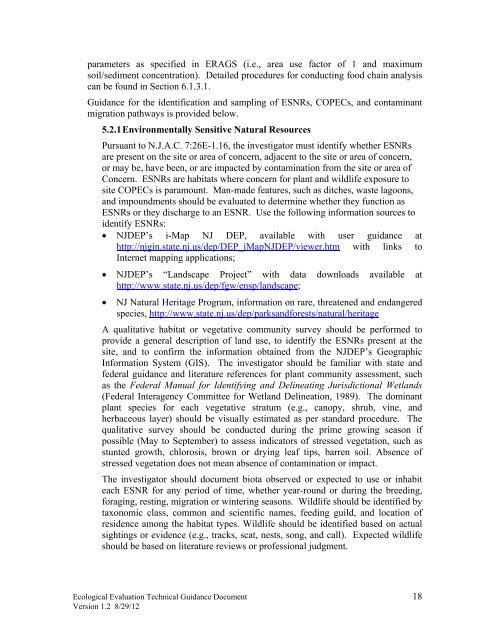Ecological Evaluation Technical Guidance - State of New Jersey
Ecological Evaluation Technical Guidance - State of New Jersey
Ecological Evaluation Technical Guidance - State of New Jersey
- No tags were found...
Create successful ePaper yourself
Turn your PDF publications into a flip-book with our unique Google optimized e-Paper software.
parameters as specified in ERAGS (i.e., area use factor <strong>of</strong> 1 and maximumsoil/sediment concentration). Detailed procedures for conducting food chain analysiscan be found in Section 6.1.3.1.<strong>Guidance</strong> for the identification and sampling <strong>of</strong> ESNRs, COPECs, and contaminantmigration pathways is provided below.5.2.1 Environmentally Sensitive Natural ResourcesPursuant to N.J.A.C. 7:26E-1.16, the investigator must identify whether ESNRsare present on the site or area <strong>of</strong> concern, adjacent to the site or area <strong>of</strong> concern,or may be, have been, or are impacted by contamination from the site or area <strong>of</strong>Concern. ESNRs are habitats where concern for plant and wildlife exposure tosite COPECs is paramount. Man-made features, such as ditches, waste lagoons,and impoundments should be evaluated to determine whether they function asESNRs or they discharge to an ESNR. Use the following information sources toidentify ESNRs: NJDEP’s i-Map NJ DEP, available with user guidance athttp://njgin.state.nj.us/dep/DEP_iMapNJDEP/viewer.htm with links toInternet mapping applications; NJDEP’s “Landscape Project” with data downloads available athttp://www.state.nj.us/dep/fgw/ensp/landscape;NJ Natural Heritage Program, information on rare, threatened and endangeredspecies, http://www.state.nj.us/dep/parksandforests/natural/heritageA qualitative habitat or vegetative community survey should be performed toprovide a general description <strong>of</strong> land use, to identify the ESNRs present at thesite, and to confirm the information obtained from the NJDEP’s GeographicInformation System (GIS). The investigator should be familiar with state andfederal guidance and literature references for plant community assessment, suchas the Federal Manual for Identifying and Delineating Jurisdictional Wetlands(Federal Interagency Committee for Wetland Delineation, 1989). The dominantplant species for each vegetative stratum (e.g., canopy, shrub, vine, andherbaceous layer) should be visually estimated as per standard procedure. Thequalitative survey should be conducted during the prime growing season ifpossible (May to September) to assess indicators <strong>of</strong> stressed vegetation, such asstunted growth, chlorosis, brown or drying leaf tips, barren soil. Absence <strong>of</strong>stressed vegetation does not mean absence <strong>of</strong> contamination or impact.The investigator should document biota observed or expected to use or inhabiteach ESNR for any period <strong>of</strong> time, whether year-round or during the breeding,foraging, resting, migration or wintering seasons. Wildlife should be identified bytaxonomic class, common and scientific names, feeding guild, and location <strong>of</strong>residence among the habitat types. Wildlife should be identified based on actualsightings or evidence (e.g., tracks, scat, nests, song, and call). Expected wildlifeshould be based on literature reviews or pr<strong>of</strong>essional judgment.<strong>Ecological</strong> <strong>Evaluation</strong> <strong>Technical</strong> <strong>Guidance</strong> Document 18Version 1.2 8/29/12
















